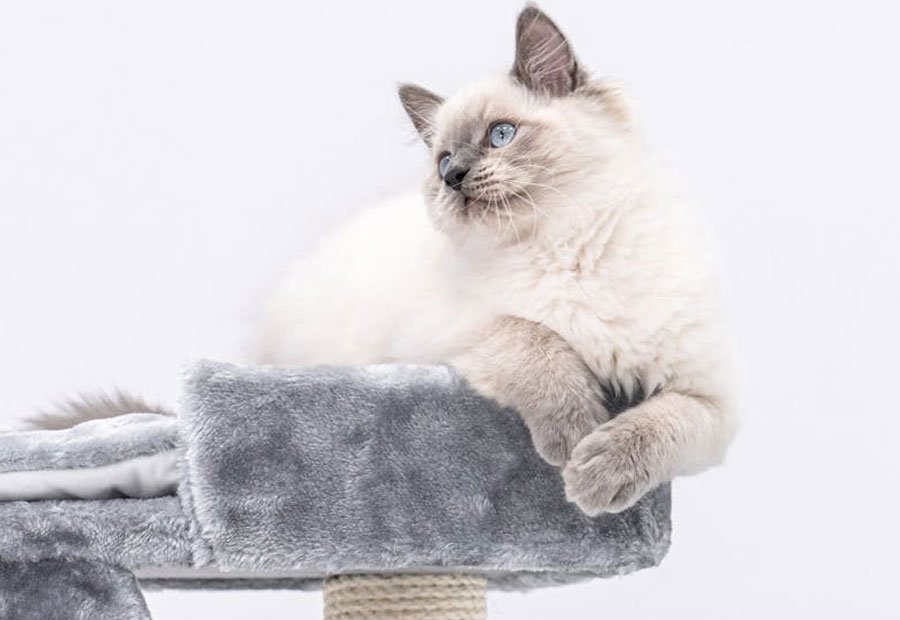Creating a stimulating environment for cats is essential to their mental and physical health, as it keeps them engaged, active, and content. Here’s a breakdown of ways to make their home environment interesting and supportive of their natural instincts:
1. Create Vertical Space
Cats love heights; it’s in their nature to seek high vantage points for observing and feeling safe. Providing vertical spaces like cat trees, wall-mounted shelves, or tall scratching posts can mimic the trees and ledges they’d climb in the wild. These additions also help create more territory in multi-cat households, reducing conflict.
Ideas for vertical spaces:
- Multi-level cat trees with hiding spaces
- Wall-mounted platforms or shelves at different heights
- Secure bookcases or cabinets for safe exploration
2. Encourage Exploration with Interactive Toys
Cats need both mental and physical stimulation, and interactive toys are excellent for providing both. Toys that mimic prey—such as feather wands, laser pointers, and even automated moving toys—can help cats satisfy their hunting instincts.
Suggested toys:
- Battery-operated toys that move or make noise
- Laser pointers (used with supervision)
- Puzzle feeders and treat-dispensing toys to engage their problem-solving skills
3. Provide Scratch-Friendly Surfaces
Scratching is a natural behavior for cats, so having appropriate scratch-friendly surfaces is a must. It helps them mark their territory, exercise their muscles, and keep their claws healthy. Offering a mix of vertical and horizontal scratching posts made of different materials (like sisal and cardboard) can give cats options they’ll enjoy.
Scratchable options to consider:
- Vertical scratching posts in different rooms
- Horizontal scratch mats
- Sisal, cardboard, and carpet materials for variety
4. Use Enrichment Tools to Simulate Natural Hunting
Feeding cats through puzzle toys and timed feeders adds an extra layer of challenge, replicating the work they’d put into hunting in the wild. Using food-based enrichment is particularly useful for high-energy cats, and it can be as simple as hiding treats around the home or placing food in interactive toys.
Easy enrichment activities:
- Hiding treats or small portions of food throughout the house
- Using kibble or treats in puzzle feeders
- Adding catnip or treats to encourage use of new toys and spaces
5. Set Up a “Window Entertainment” Area
Cats love to observe the outside world, and setting up a window perch or seat is an easy way to create endless entertainment. Birds, leaves, and other animals moving outside can be fascinating to watch and stimulate their minds.
Ideas for window areas:
- Window perches with suction cups
- Placing bird feeders or squirrel feeders outside the window
- Cat-safe screens for a secure view when windows are open
6. Rotate Toys and Add New Ones Regularly
Cats can lose interest in toys that are always available, so try rotating toys and adding new ones to keep things exciting. You don’t need a large collection; swapping out toys every few weeks can make old toys feel new again.
7. Introduce Safe Plants and Natural Scents
Certain cat-safe plants like catnip, silvervine, and cat grass are known to have a positive effect on cats, encouraging playfulness and curiosity. Similarly, introducing new scents with catnip or placing worn clothing with familiar scents can create comfort and stimulation for cats.
Ideas for plant and scent enrichment:
- Grow some cat grass or catnip indoors
- Use catnip sprays or silvervine powder on toys
- Include familiar scents, like blankets or clothing with your scent, especially if you’re away
8. Incorporate Hiding Spaces and Cozy Nooks
Having safe spaces to hide in is as important to a cat’s comfort as active play areas. Cats feel more secure with access to small, cozy spaces where they can retreat and rest. Boxes, covered beds, and cat tunnels are great additions.
Ways to add hiding spaces:
- Small cardboard boxes in different areas
- Cat tunnels and soft beds tucked away from high-traffic spots
- Covered beds or soft carriers that are left open
9. Social Stimulation with Quality Time and Training
Finally, regular interaction is key to keeping cats engaged. Teaching simple tricks with treats and toys can be a fun bonding activity that keeps your cat mentally stimulated. Playing with your cat daily, even for short bursts, can significantly enhance their happiness.
Creating a stimulating environment for cats is about balancing their need for physical exercise, mental challenges, and a sense of security. With the right mix of activities and spaces, you can provide an enriched home that keeps your cat healthy and happy.

